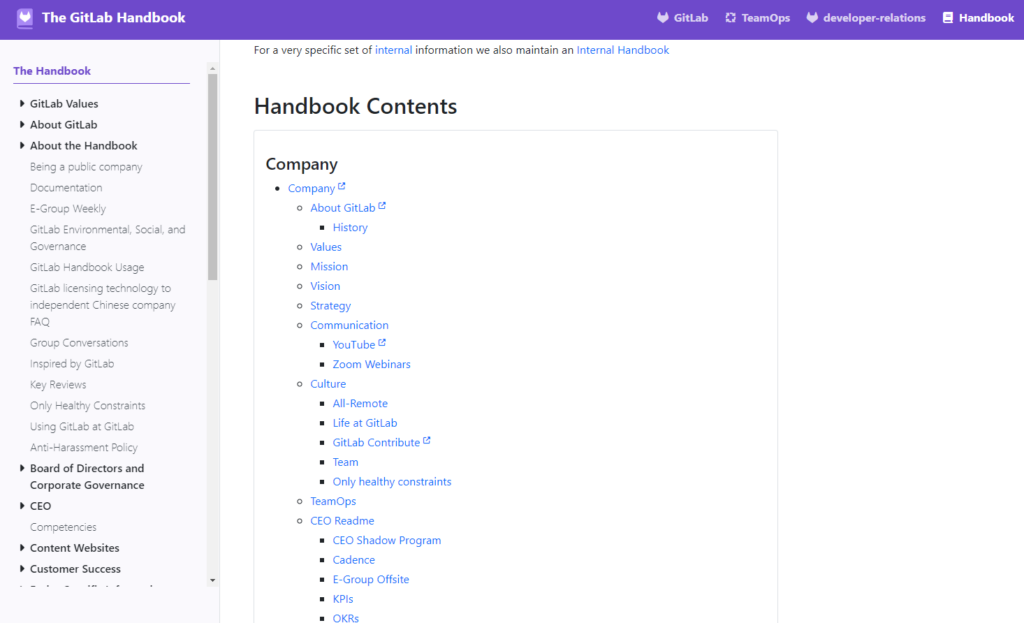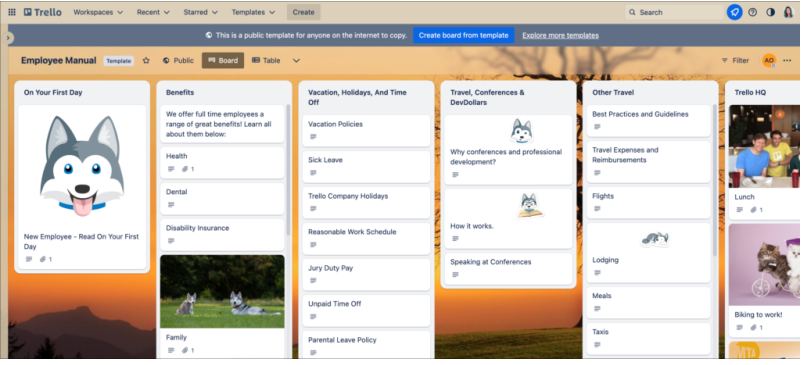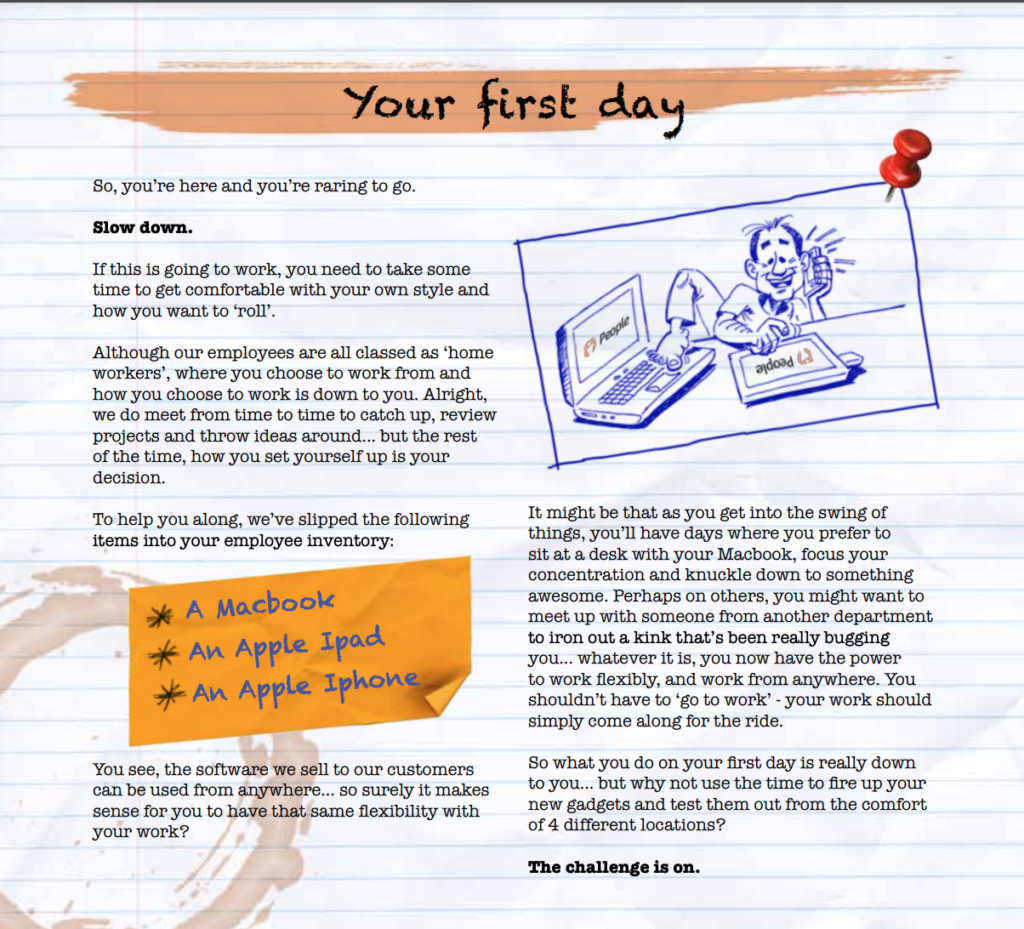Employee handbooks have changed dramatically since I first created one and I’ve learned a lot about the importance of employee relations in that time.
Today, employees expect handbooks to not only be informative (defining every company policy) but also engaging, attractive and far easier to digest than the 60-page behemoths of yesteryear.
That length is perhaps why it was estimated in 2020 that 60% of employees avoid reading employee handbooks. So let's dig into how you can make yours better.
What is an Employee Handbook?
An employee handbook serves as a guide for both management and staff. It outlines the company's policies, procedures and expectations, ensuring a clear understanding of workplace norms and legal obligations.
The handbook typically includes sections on company culture, core values and mission, as well as practical information like work hours, dress code and leave policies.
It may also cover anti-discrimination policies, health and safety regulations and disciplinary procedures.
Why Is It Important To Have An Employee Handbook?
An employee handbook is a repository of information about the organization that existing and new employees can reference and learn from.
According to a recent survey conducted by People Managing People on LinkedIn, 71% of respondents indicated that their organization already has an employee handbook, while 19% responded that they had plans to develop one, or were in the process of developing one.

An employee handbook can be extremely beneficial to team members and the entire organization in several areas.
Successfully Onboard New Employees
An employee handbook is a critical tool for new hire orientation and onboarding. Research by Glassdoor found that organizations with a strong onboarding process improve new hire retention by 82 percent and productivity by over 70 percent.
An employee handbook is used to educate new employees on the rules and processes that govern the employment relationship, and the rights, responsibilities, and expected behaviours of the employer and the employee.
It’s also an important tool for new team members to understand everything from what their first weeks and months of work will be like, to what they should wear to work (note: be careful with dress codes!).
For this reason, it's not a bad idea to disseminate an employee handbook during the preboarding process. Attaching it to the welcome letter is a good tactic.
Build A Strong Company Culture
An employee handbook is much more than just an HR policy manual. An employee handbook gives you the opportunity to define in words and images your company culture, and communicate it to new and existing employees.
A key piece of building a great culture is to articulate your company’s vision, define the core values and beliefs of your organization, and describe the types of behaviours and actions you expect from team members to support those values.
Patagonia does an excellent job of this in their employee handbook, where they describe their purpose as, “We’re in business to save the planet”, and their company mission to, “Build the best product, cause no unnecessary harm, use business to inspire and implement solutions to the environmental crisis.”
Attract And Hire Great People
A great employee handbook can create a competitive advantage for organizations competing to hire top talent. Many companies have made their employee handbooks public, and have formatted them in innovative ways to get potential employees eager and excited to join.
For example, Valve publicly released its employee handbook in 2012 and generated significant positive press with its unique style and colorful descriptions of the company’s work environment.
You can use your employee handbook to articulate and promote what makes your organization special, unique employee benefits, and your position on current issues such as equal employment opportunity, non-discrimination, and COVID-19 safety.
Meet Legal And Employment Law Requirements
An employee handbook helps you document and organize information that is directly related to the employment contract the employment relationship e.g. at-will employment), and applicable employment law (provincial / state laws, federal laws).
For example, employment legislation like the Family and Medical Leave Act (FMLA) in the United States, and the Employment Standards Act of BC in Canada, set out the minimum requirements of employers with respect to many of these policies.
Who Is Responsible For Creating An Employee Handbook?
Human resources typically coordinates the creation of an employee handbook. However, in organizations that don’t have an HR team or person, that responsibility may fall to a:
- Founder or business owner;
- Administrative or executive assistant;
- External HR consultant; or
- Handbook committee
This person would be responsible for collecting the required information through interviews with key employees; research into existing policies and procedures; and research into industry best practices.
Important Note: the person responsible for creating the handbook may not be the same person who actually writes, formats, and publishes the handbook since this often requires strong copywriting, content creation, and graphic design skills. A good marketing agency or PR firm can help take your handbook to the next level.
What Is An Employee Handbook Committee?
A handbook committee may be found in larger organizations and often includes executives, leaders, and individuals from across the organization. The handbook committee is typically responsible for:
- Determining the strategic purpose of the handbook;
- Providing high-level guidance on content and tone;
- Deciding how the handbook should be used by the organization;
- Overseeing handbook creation; and
- Gathering all the handbook content.
What Should I Call My Employee Handbook?
“Employee handbook” is most commonly used because it’s more widely understood, while titles like “employee manual” and “HR policy manual” are less often used because they sound too bureaucratic, rigid, and formal.
What you call your employee handbook will be one of the decisions you must make along the way. This decision will be guided by what you feel is the main purpose of the handbook itself, your company culture, and your own personal preference.
For example, many organizations, such as Netflix and HubSpot, refer to their handbooks as “Culture Codes” or “Culture Guides”, to indicate the purpose of the handbook as a culture-building tool, rather than a company policies and procedures manual.
Examples of How to Create a Successful Employee Handbook
An effective employee handbook is one that engages and educates new and existing employees, motivates potential employees to join the organization, and grows both employees and the company.
The following are some of the key success factors that can make or break a great employee handbook:
Engaging And Organized Content
Like a good novel, you need to make sure the content of your employee handbook is well-written, interesting, and hopefully even entertaining at times. The structure, and the order in which information is presented, should be logical and intuitive.
Include hyperlinks (for digital versions), a table of contents, and an index to make it easier for employees to find the information they’re looking for, and a glossary to help someone quickly reference company-specific acronyms and jargon.
A good example of this comes from GitLab.

Finally, use content from the many employee handbook examples referenced throughout this article as a starting point to develop your own content, rather than starting from scratch. However, be aware of copyright rules, particularly if you’re going to publish your handbook publicly.
Compelling Look And Feel
The “look and feel”, or the tone, of a handbook should align with the company culture and values. The right tone can work together with engaging content to create an informative and entertaining resource that people actually want to read.
The Valve handbook is a great employee handbook example that uses elements such as:
- Conversational tone: use contractions like “it’s”, rather than “it is”, to make the material more accessible and easier to read.
- Photos and images: include images of things like actual employees and company workspaces to help new employees understand the organization better.
- Creative visuals: use infographics, fun cartoons, and bulleted lists where possible to leverage the brain’s love of pictures and visuals.
- Humour: a little light-hearted humor can go a long way toward helping ease people into topics that aren’t as interesting, but are necessary to include.

For example, consider prefacing a parental leave policy with something light and fun, like: “Expecting a little one? Having a baby is a proud time for parents, so it’s only fair that you both get some time off to enjoy the experience and recuperate.”
Easily Accessible
You could create the greatest employee handbook in the world, but it wouldn’t matter much if no one knows where it’s located, or if the format makes it difficult to distribute.
While you want to give people the option of printing a handbook, it should ideally be available primarily in a digital format, and easily accessible on your company’s intranet or a shared network drive.
Try leveraging employee handbook software from companies like AirMason and Blissbook to help you create and easily maintain a visually compelling handbook.
Or get creative like software company Trello, which uses their own software platform for their employee manual.

Related Read: Thinking About An Employee Intranet? Read This First
Constantly Updated
Your organization is constantly changing, so your employee handbook should too.
Treat your handbook like a living document that requires regular maintenance.
Solicit feedback from new employees as they go through orientation on what can be added or improved. Keep tabs on the latest HR trends and best practices in employee onboarding and stay on top of the latest developments in employment law to know which company policies and procedures might need to be updated.
Contents Of An Employee Handbook
In the past, an employee handbook was mostly used as a human resource (HR) policy and procedures manual.
Today, employee handbooks typically contain a mix of different elements essential for existing employees, and new employees during orientation and onboarding.
Welcome And Introduction
Start the employee handbook with a welcome letter—or even better, a welcome video like the one below from Uber—from the founder, CEO, or leadership team.
This provides new team members with valuable insight into the company, why it’s in business, what part employees play in the organization’s success, and the purpose of the employee handbook itself.
You can find an example welcome letter in our free employee handbook template at the end of the article.
Company And Culture Overview
This section of your handbook is important in helping prospective or new employees understand more about your company’s mission, culture, and story. Your handbook should incorporate the following elements, and the order is up to you:
- Vision statement: what is the purpose of your company; why do you exist?
- History and timeline: where did your company come from, and how has it evolved?
- Mission statement: how will your organization achieve its vision and goals?
- Core values: what organizational beliefs guide people’s behaviours and decisions?
- Organization structure: how are teams and employees organized?
Zappos’ Culture Book is a great example of how an employee handbook can be used to communicate the real essence of who they are to potential employees.


New Hire Orientation Information
This part of your employee handbook will cover what a new team member can expect on their first day and in their first week(s) of work, such as:
- Office/facility tour
- Team introductions
- Dress code (if applicable)
- Training schedules
- Tools and resources
- Key contacts
For example, HR software company People includes an overview in their great employee handbook of what new team members can expect on their first day and in their first month.

Company Policies
Many companies have their detailed HR policies and procedures in a separate manual, and only touch on some of the most important ones in their employee handbook. This makes sense particularly if the purpose of your employee handbook is to promote your company culture, rather than list out a bunch of rules.
If you’re not sure which HR policies to include in your handbook, check out this article, and start with these ones:
- Diversity, equity, and inclusion
- Workplace safety and health
- Harassment and sexual harassment
- Remote work and telecommuting
- Social media
- Paid time off (PTO), vacation time
- Leave eligibility e.g. sick leave, jury duty
Personal And Career Development
According to LinkedIn’s 2018 Workforce Learning Report, a whopping 93% of employees would stay at a company longer if it invested in their careers. This part of your employee handbook should cover things like:
- Performance management
- Applying for internal job postings
- Internal training programs
- Education and tuition assistance
Employee Rewards, Benefits, And Perks
This is your opportunity to promote the compensation and rewards your organization offers to employees you want to hire, and get new employees educated and excited. This section can include information such as:
- Rewards philosophy: for example, do you pay at the top of the market?
- Compensation elements: salary, bonuses, stock options, hourly overtime, etc.
- Compensation reviews: how often, what’s the process, and impact on compensation
- Benefits programs: health insurance, wellness programs, RRSP / 401(k), etc.
- Perks: car allowance, expense account, technology benefits, fitness allowance, etc.
Netflix does an excellent job in their Employee Culture Guide of explaining their rewards philosophy and how annual compensation reviews are handled.
General Workplace Information
This can be a catch-all of all the other information you feel is important to share with new, existing, and potential employees that will educate them on the workplace culture and get excited about working for you, such as:
- Office and facility information
- Work environment e.g. cubicles, offices, eating areas, shared spaces
- Recreation facilities e.g. ping pong tables
- Team events e.g. holiday parties, summer BBQs
- Bringing pets to work
The Valve Employee Handbook is a great example of how to give people a strong understanding of what it’s like to work there.
What Are The Steps To Create An Employee Handbook?
Rome wasn’t built in a day, and neither will your employee handbook. Creating a great employee handbook will take time, patience, and a lot of support from people in your organization.
Following are the steps you, or your handbook committee, will need to take to launch your new handbook:
- Get buy-in from senior leadership: if you’re not the senior leader in your organization, your handbook will be dead in the water without their approval and support.
- Decide on the purpose(s): figure out your vision for the handbook, and the goals you’d like it to achieve, which will drive many of your content and delivery decisions.
- Research the legal requirements: avoid legal pitfalls and work with your employment lawyer if you’re unsure of what you can and can’t put in your handbook.
- Review best practices and examples: you’ve already done some of this by reading this article! Also, check out the great employee handbook examples listed throughout.
- Create the content and structure: gather all the information you want to include, figure out how to organize it, and get writing!
- Decide on format and access: determine if your handbook will be published as a slide deck, web page, etc.; if it can be downloaded/printed; and where people can access it.
- Review with leadership and legal counsel: get the final ok and sign-off from the powers-that-be.
- Publish and celebrate: get the handbook out there, have a little party, promote it at your next all-hands meeting, and get people using it!
- Review and maintain regularly: oh, you thought you were done when you published it? Think again… :-)
Free Employee Handbook Template
Right here! We’ve created a Word doc that you can use as a guide to create your own handbook. It’s a skeleton of an employee handbook for a fictional company, FACT Technology, and includes a bunch of sample content to help get you started and the creative juices flowing!
But before you jump in, remember the following:
- The tone and content of your employee handbook should fit your organization.
- The template contains only text. Your final handbook should not.
- The template is a Word document. Your final handbook can also be, but also consider using web-based alternatives like AirMason, which you can upload your Word doc into.
Download the template below!
Get our employee handbook template!
What Do You Think?
What’s one of the best employee handbook examples you’ve ever seen? What made it so great? What was the worst one, and why? What’s the most important content you think should be included in the first version of a handbook, and why?
Discuss your ideas in the People Managing People community forum (join the waitlist here!) or share your thoughts in the comments below.
You can also subscribe to the People Managing People newsletter to stay up to date with the latest thinking in HR from leadership and management experts from around the world.
Related Read: The Case For A New Employee Handbook (And What To Include)



